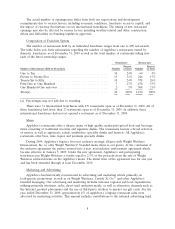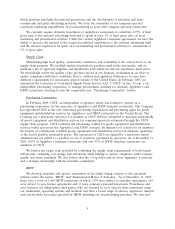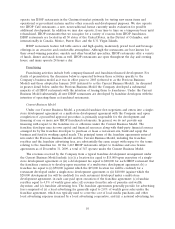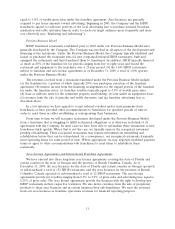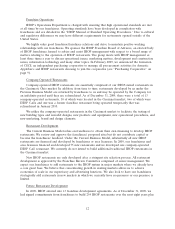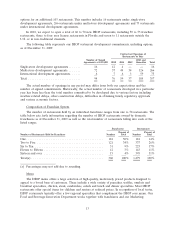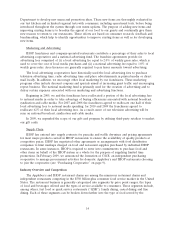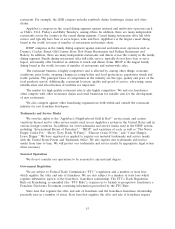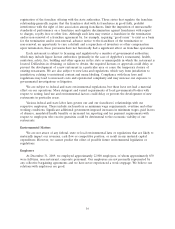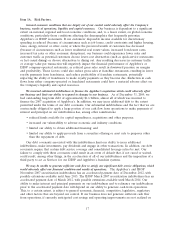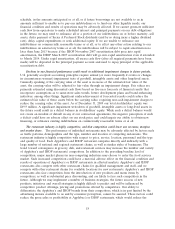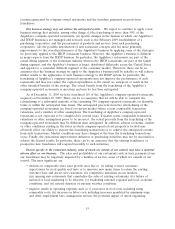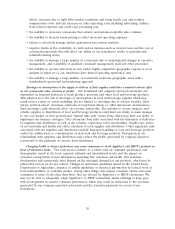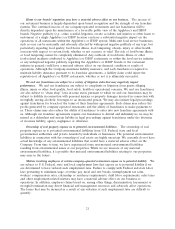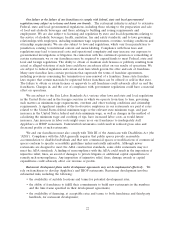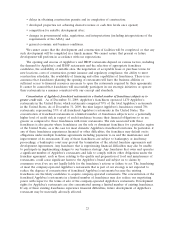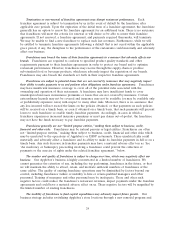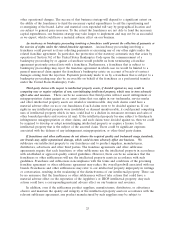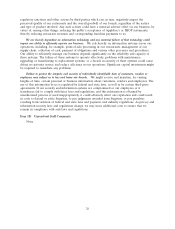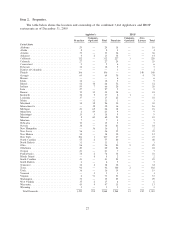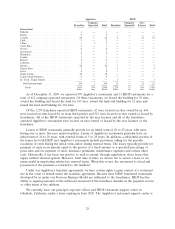IHOP 2009 Annual Report Download - page 37
Download and view the complete annual report
Please find page 37 of the 2009 IHOP annual report below. You can navigate through the pages in the report by either clicking on the pages listed below, or by using the keyword search tool below to find specific information within the annual report.schedule, in the amounts anticipated or at all, or if future borrowings are not available to us in
amounts sufficient to enable us to pay our indebtedness or to fund our other liquidity needs, our
financial condition and results of operations may be adversely affected. If we cannot generate sufficient
cash flow from operations to make scheduled interest and principal payments on our debt obligations
in the future, we may need to refinance all or a portion of our indebtedness on or before maturity, sell
assets, defer payment of Series A Preferred Stock dividends (and by so doing incur a higher dividend
rate), delay capital expenditures or seek additional equity. If we are unable to refinance our
indebtedness on commercially reasonable terms or at all, or to effect any other action relating to our
indebtedness on satisfactory terms or at all, the indebtedness will be subject to rapid amortization no
later than June 2013 because if the IHOP November 2007 securitization debt goes into rapid
amortization, the IHOP March 2007 securitization debt will go into rapid amortization even if extended
to March 2014. Under rapid amortization, all excess cash flow (after all required payments have been
made) will be deposited in the principal payment account and used to repay principal of the applicable
securitization debt.
Declines in our financial performance could result in additional impairment charges in future periods.
U.S. generally accepted accounting principles require annual (or more frequently if events or changes
in circumstances warrant) impairment tests of goodwill, intangible assets and other long-lived assets.
Generally speaking, if the carrying value of the asset is in excess of the estimated fair value of the
asset, the carrying value will be adjusted to fair value through an impairment charge. Fair values are
primarily estimated using discounted cash flows based on five-year forecasts of financial results that
incorporate assumptions as to same-store sales trends, future development plans and brand-enhancing
initiatives, among other things. Significant underachievement of forecasted results could reduce the
estimated fair value of these assets below the carrying value, requiring non-cash impairment charges to
reduce the carrying value of the asset. As of December 31, 2009 our total stockholders’ equity was
$69.9 million. A significant impairment writedown of goodwill, intangible assets or long-lived assets in
the future could result in a deficit balance in stockholders’ equity. While such a deficit balance would
not create an incident of default in any of our contractual agreements, the negative perception of such
a deficit could have an adverse effect on our stock price and could impair our ability to obtain new
financing, or refinance existing indebtedness on commercially reasonable terms or at all.
The restaurant industry is highly competitive, and that competition could lower our revenues, margins
and market share. The performance of individual restaurants may be adversely affected by factors such
as traffic patterns, demographics and the type, number and location of competing restaurants. The
restaurant industry is highly competitive with respect to price, service, location, personnel and the type
and quality of food. Each Applebee’s and IHOP restaurant competes directly and indirectly with a
large number of national and regional restaurant chains, as well as similar styles of businesses. The
trend toward convergence in grocery, deli, and restaurant services may increase the number and variety
of Applebee’s and IHOP restaurants’ competitors. In addition to the prevailing baseline level of
competition, major market players in non-competing industries may choose to enter the food services
market. Such increased competition could have a material adverse effect on the financial condition and
results of operations of Applebee’s or IHOP restaurants in affected markets. Applebee’s and IHOP
restaurants also compete with other restaurant chains for qualified management and staff, and we
compete with other restaurant chains for available locations for new restaurants. Applebee’s and IHOP
restaurants also face competition from the introduction of new products and menu items by
competitors, as well as substantial price discounting, and are likely to face such competition in the
future. Although we may implement a number of business strategies, the future success of new
products, initiatives and overall strategies is highly difficult to predict and will be influenced by
competitive product offerings, pricing and promotions offered by competitors. Our ability to
differentiate the Applebee’s and IHOP brands from their competitors, which is in part limited by the
advertising monies available to us and by consumer perception, cannot be assured. These factors could
reduce the gross sales or profitability at Applebee’s or IHOP restaurants, which would reduce the
18


